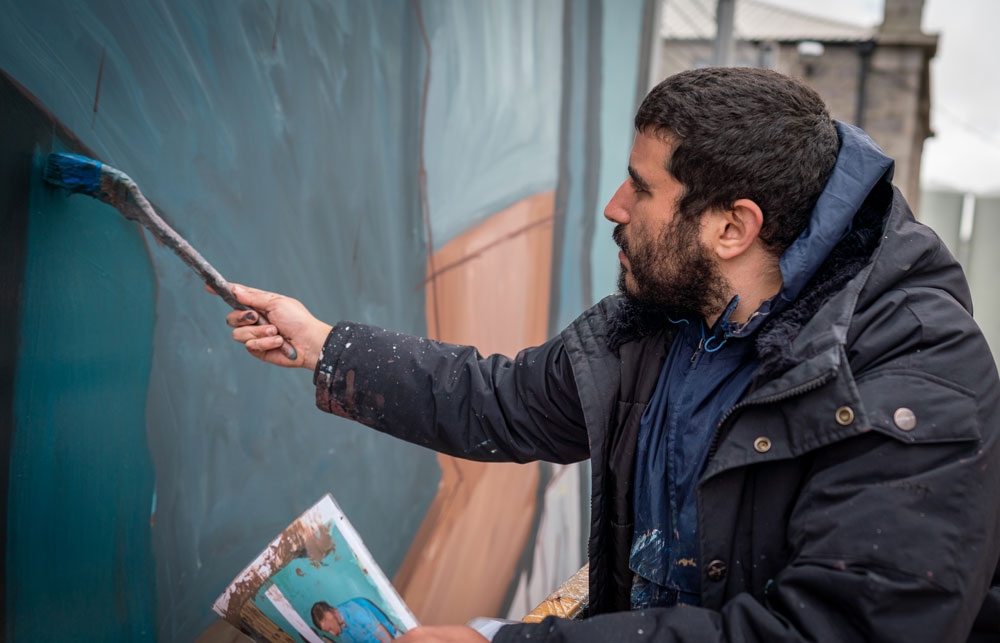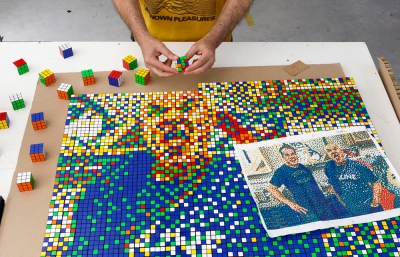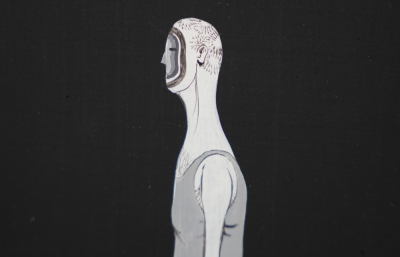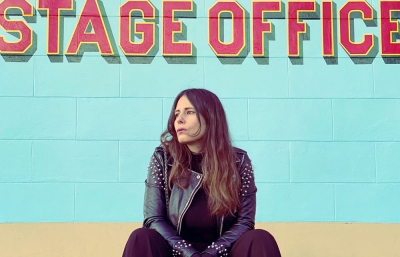Mohamed l'Ghacham
The Time Traveller
Interview by Evan Pricco // Portrait by Brian Tallman
There is a certain tone, a color that seems to imbue a found photo. It doesn’t matter what era it was taken, or from where it was obtained, but a film photo immediately creates a mood that is universal. Maybe we all look at the past through sepia-tinted glasses, with a tinge of nostalgia and wonder of how our own memories might look like to someone else if they somehow accessed our family albums.
Moroccan-born, Madrid-based painter Mohamed l'Ghacham has delicately archived memories and the mundane brilliance of everyday life and transformed these found photos into murals and paintings that feel deeply personal while simultaneously universal. His subject matter is commonplace, but the color palette is cinematic. People gather for meals, dance at parties, and pose for family portraits. In a time when intimacy with loved ones was temporarily snatched away, l'Ghacham’s works provided a vital, visceral form of communication. Dig deeper, and he is reinvigorating spaces that have been abandoned or adding personality to neighborhoods where perhaps an advertisement or billboard has taken some of the local character away. But really, it’s simple: he’s bringing a surge of life back to our cities.

Evan Pricco: I wanted to start talking about memories, and your own childhood and times with your family. Do you feel nostalgic about these murals, and if so, is there a certain time you are nostalgic for?
Mohamed l'Ghacham: I couldn't tell you if I'm a particularly nostalgic person, but I do find myself drawn to scenes or situations that could be labeled as such. In general, I consider myself a person who lives in the present and is generally quite cheerful and positive. But it is true that if you know me only by my painting I can give the impression of being someone who is nostalgic or even sad. I suppose that, in my case, my paintings do not correspond entirely with my personality, although I try to be as sincere as possible in my work.
A time I remember with great fondness and nostalgia is the time in high school when I started painting graffiti with my classmates. It was fun, with no intention of achieving anything special, and every little "improvement" was celebrated as a great achievement. Everything was much more innocent. I think I do feel a lot of nostalgia for that particular time.
I guess a basic place to start is where you grew up and how Morocco plays into the work. And how does Spain now influence you?
I was born in Tangier, Morocco, but a few months later my parents emigrated to Spain. My memories of Morocco are usually memories of summer vacations or certain situations. Growing up in Spain, my influences are generally similar to any other Spanish painter, but it is true that because of the education I received at home and my cultural heritage I also have many connections with the Arab world and the religion of Islam. To tell you the truth, this isn’t something that I ever gave much importance to. But these last few years I have been painting some pieces that are more related to Arab life and its aesthetics. For some time now I've had the feeling that this is what I want to paint and I think that something interesting can come out of all that cultural heritage. We'll see if it gets anywhere or if there are only four or five pieces left for me to explore.

When did you start with the process of taking found photos and videos and transforming them into murals on a large scale and paintings on a smaller scale?
I could not tell you exactly when it started, but I guess it was when I began to see a special magic in the color and atmosphere of analog photographs and home videos and especially family photographs that are usually "accidents." Like unprepared situations, when models do not even look at the camera, totally naturally, with compositions that have nothing to do with professional photography. I think that this naturalness and the feeling that a single image can tell you a story are what encouraged me to follow this line. On the other hand, I really like the idea of painting these everyday situations on a large scale without ornament or elements, attracting attention to buildings in the middle of cities. It seems to me a good contrast to advertising and strident colors and scenes.
I also have to say, before I used these kinds of images as a reference for my work, there were already a considerable number of artists who have been investigating that same line. Maybe not with the same intention, but they were key for me in following that path.
When you research a city archive or look through your source material, how do you know you have found the absolute right image?
Many times I already have, more or less, a mental scene thought out so that my work has a certain coherence. What I do in those cases is look for the image that most resembles what I want to explain and I adapt it to what I'm looking for by removing or adding elements. The good thing about painting in the street is that many times the wall itself or the environment already tells you what image or scene works best. I try to be respectful of the space and try to put myself in the shoes of the neighbors who will have to see the mural every day. I guess I don't fully know if I've found the right image until I'm done and I see the reaction of the mural to its surroundings. It's hard for me to have an objective opinion of my work when I've just finished it. Often murals that I hated end up becoming pieces that I like and the other way around. But in short, if I don't invasively contaminate the visual space with my piece, I think it's a correct image. Whether it's better or worse is another story.

I heard you say that the works you were painting on walls were abandoned spaces, and you were sort of bringing the spaces back to life. I hope this makes sense, but they almost appear like ghosts of the past. Does that make sense? Like the energy that is left behind. What do you think of that?
I grew up in Mataró, a small town on the outskirts of Barcelona. In this area, there are a lot of factories and industrial buildings that, because of the 2008 crisis, had to close. This was the year I started painting in the street. Both my friends and I started painting our first graffiti in abandoned factories and so spent many weekends and afternoons after school in such places. Many of them were still equipped and with lots of notes, calendars, and things like that. It seemed incredible to us to be alone in such large places where there had been so much life and so many people just a short time before.
That feeling of painting "life" in dead places increased even more when I started painting more realistic scenes that had more to do with painting than conventional graffiti. On the other hand, I am part of a generation that grew up seeing a lot of pieces by Aryz, Gr170, Kikx, and that group. They had spectacular pieces both for quality and size in any abandoned factory you visited. Those people, in particular, made me see that there were other languages when working in the street and that by replacing the sprays with paint, rollers, and extension sticks you could take advantage of a wall much more, and reach higher to achieve finishes that are unthinkable with the spray.
Thinking about it now, I was very lucky to have references that investigated other ways and opened the way for me and many other young artists.
Do you change your process if it is a mural or if it is a painting for a show? Do you have different approaches?
I think many muralists would agree that painting a mural is much easier than doing a painting in the studio. I wouldn't know why. But I think that, in my case, time is of the essence. When I'm on a wall it's a fight against the clock and you know you have deadlines to meet. That makes me more decisive (sometimes more successful, sometimes less so) and I don't doubt so much what I'm doing. I know there is no turning back. The environment also plays an important role, and the city supports a painting better than a white wall.
When I'm in the studio I tend to be more insecure, I erase, repaint, and even abandon paintings for a few months. It's much harder for me to know if I'm doing things right or if I'm completely lost. That's the battle. The process is similar, although in the studio I work with oil paint, and perhaps in the studio, I do give more importance to the format. Another good thing about the street is that you adapt to the format of the wall and it forces you to look for compositions that perhaps you didn't even think you could do.

I would imagine that, for so many people, myself included, the pandemic made me look at your work in a different way. It was this sort of longing for connection, or missing someone, or missing gatherings. What appeared to be these fragments of time seemed vital to a collective consciousness. Did you feel like your work or the way you looked at your own work changed?
I think that's the same feeling we have when we think about the past. We tend to remember only the good times. My paintings usually represent moments of calm and reunion and it is easy to transport you to moments that the pandemic unfortunately took away from us for many months.
How nice to think that my work has made you remember such beautiful and special moments, so, thank you very much. I guess it's the same feeling I have with movies or specific works of art. No doubt the pandemic has given us another point of view on many things we didn't realize we cared so much about.
I wonder if it has ever happened that someone is actually recognized in your work.
I have never been contacted by an anonymous person, honestly. What has happened is that many times neighbors give me their family albums as a gift and the person who is the protagonist of the mural may not know about it until they see it painted. I am also a person who usually asks for a lot of photographic material from my friends and acquaintances, and maybe I paint them years later and they don't even remember that they have shown them to me. I can paint a mural based on a photo that was given to me six or seven years ago and it is normal that many times the "models" don't even remember that I asked them for those photos.

What do you value the most now that the world is re-opening and your work is getting more attention? What do you value in your own life or look at differently, especially because you are painting such universal and intimate moments?
I feel that now is a time when more people are getting to know my work and it precisely coincides with a time when I am less proud of what I do! It's funny, I guess, but it's part of the process. Maybe now I see mistakes that I wasn't able to see before.
I have always very much valued the time with my girlfriend, my friends, and my family, things I try to keep alive, even if I am in a different city. I think the importance I give to my close circle, even if it is small, is what makes me interested in intimate or personal scenes. I value that my people and I are doing well and that I am still living from painting, something I always find hard to believe.
Where would you like to take this work? Do you have ideas that you would like to present given the involvement of more found photography and research in city archives?
Since I had the opportunity to paint buildings, it seems that the main theme of my painting has revolved around a western vision of everyday life. I feel ready and eager to start telling another story and another point of view. Whenever I visit my mother and go through our family albums, I feel that, despite being in very similar situations to those I have already painted, they give me another kind of feeling beyond the aesthetic difference. I think I would like my work to pass at some stage over all my cultural heritage and maybe now might be a good time.
On the street, I really wanted to be able to present a series of murals that somehow tell a story, beyond making a single large format image. Recently, I was lucky enough to be able to do something similar to that and now I am looking forward to returning to painting scenes of houses or interior rooms without characters. That’s something very attractive to me, and that I think can represent many people who live with the mural.

How is life in Madrid these days, and what's up next?
I’ve been living in Madrid since January of this year, but I don't think there's much difference with Barcelona, at least not for me. I'm a simple and quite solitary person. I go from the studio to home and from home to the studio when I'm not traveling to paint walls.
I've been very uncomfortable in the studio for a while, but if I manage to solve that situation I hope to be able to do my third solo exhibition in 2023. Time will tell if something worthwhile comes out of it. I will continue traveling and painting murals, of that I am sure.






